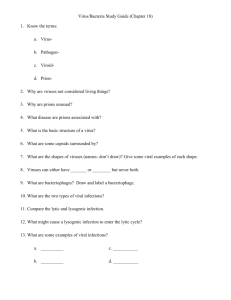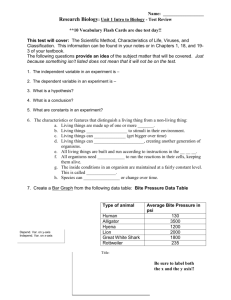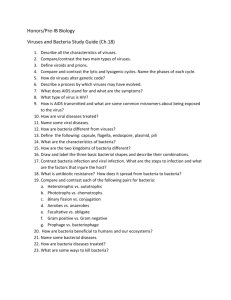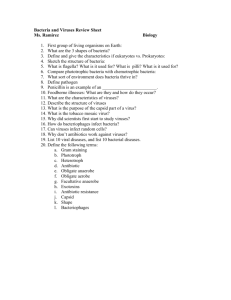Chapter 19 Notes: Viruses & Bacteria VIRUSES A. Viral Life
advertisement
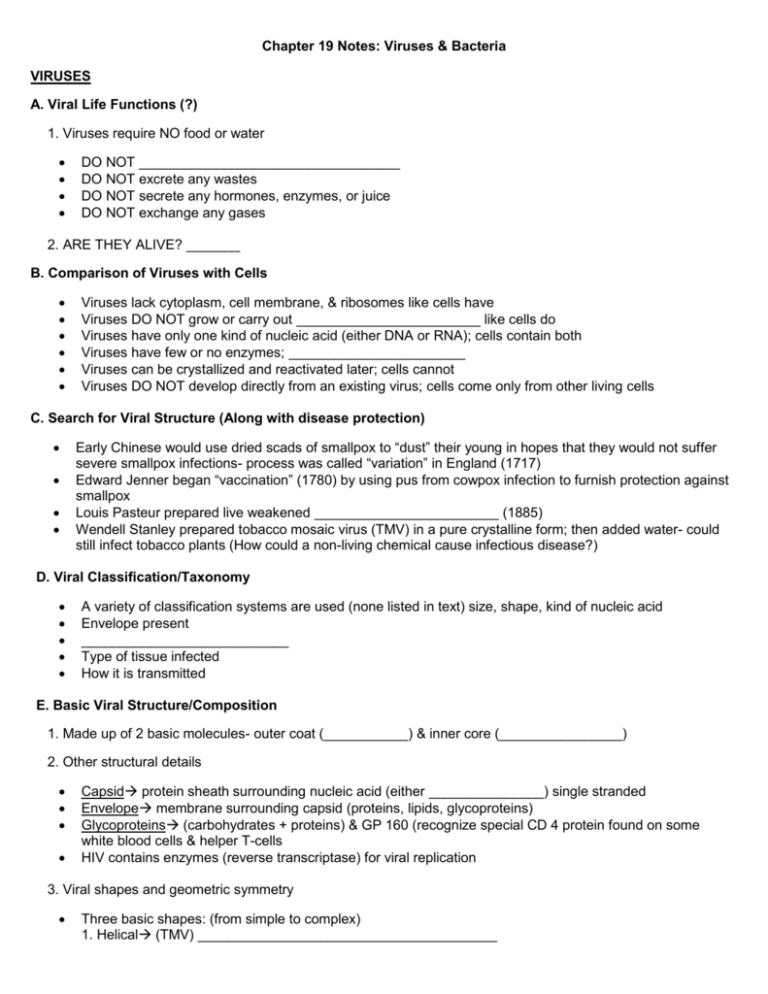
Chapter 19 Notes: Viruses & Bacteria VIRUSES A. Viral Life Functions (?) 1. Viruses require NO food or water DO NOT __________________________________ DO NOT excrete any wastes DO NOT secrete any hormones, enzymes, or juice DO NOT exchange any gases 2. ARE THEY ALIVE? _______ B. Comparison of Viruses with Cells Viruses lack cytoplasm, cell membrane, & ribosomes like cells have Viruses DO NOT grow or carry out ________________________ like cells do Viruses have only one kind of nucleic acid (either DNA or RNA); cells contain both Viruses have few or no enzymes; _______________________ Viruses can be crystallized and reactivated later; cells cannot Viruses DO NOT develop directly from an existing virus; cells come only from other living cells C. Search for Viral Structure (Along with disease protection) Early Chinese would use dried scads of smallpox to “dust” their young in hopes that they would not suffer severe smallpox infections- process was called “variation” in England (1717) Edward Jenner began “vaccination” (1780) by using pus from cowpox infection to furnish protection against smallpox Louis Pasteur prepared live weakened ________________________ (1885) Wendell Stanley prepared tobacco mosaic virus (TMV) in a pure crystalline form; then added water- could still infect tobacco plants (How could a non-living chemical cause infectious disease?) D. Viral Classification/Taxonomy A variety of classification systems are used (none listed in text) size, shape, kind of nucleic acid Envelope present ___________________________ Type of tissue infected How it is transmitted E. Basic Viral Structure/Composition 1. Made up of 2 basic molecules- outer coat (___________) & inner core (________________) 2. Other structural details Capsid protein sheath surrounding nucleic acid (either _______________) single stranded Envelope membrane surrounding capsid (proteins, lipids, glycoproteins) Glycoproteins (carbohydrates + proteins) & GP 160 (recognize special CD 4 protein found on some white blood cells & helper T-cells HIV contains enzymes (reverse transcriptase) for viral replication 3. Viral shapes and geometric symmetry Three basic shapes: (from simple to complex) 1. Helical (TMV) _______________________________________ 2. Cubic (Adenovirus) polyhedrons- faces + corners (icosahedrons- 20 faces & 12 corners) 3. Complex (T2 bacteriophage)- complex head with tail F. Viral Reproduction (Can ONLY reproduce inside a living host cell) 1. Viruses are very ____________ as to host or target they infect- only certain organisms or kind of tissue Ex: Bacteriphage (bacteria); Polio (nerve tissue); Rhinovirus (respiratory membrane) 2. Viral infection may be ________ or lysogenic (Hershey & Chase Exp) 3. Viral genetic material must be replicated and translated in host- normal flow of information “central dogma” (from DNA RNA PROTEIN) in most viruses just like prokaryotic & eukaryotic cells = but there are a few viruses Retroviruses where information flows differently (from RNA DNA RNA PROTEIN) The HIV is an RNA virus and contains an enzyme reverse transcriptase (________________) G. Protection from Viral Infection (Prevention/treatment mainly) Immunity (acquired- vaccination or previous occurrences; _____________________________) Interferon & protease inhibitors- viral “cocktails” for HIV Antibiotics are NOT effective (NO METABOLIC PROCESSES)- not many cures available, if any Drug store is full of chemicals providing temporary symptomatic relief- analgesics (pain), antipyretics (fever), antihistamines (fluids), antitussives (coughs) H. Economic Importance of Viruses 1. Viral disease plague humans from conception to death- they also affect many other plants & animals that humans value or need 2. Viruses can be used as “vectors” to move genetic material between species (Hershey/Chase Transduction EXP) or moving human genes for making growth hormone or insulin into bacteria or yeast cells 3. Development of vaccines- studying and growing viruses in viruses living cells (ex: tissue culture, chick embryos, monkeys, mice) Viral Diseases Measles Yellow Fever Chicken Pox Influenza Small Pox Common Cold Fever Blisters Sinusitis Cold Sores Distemper (Dogs) Encephalitis HIV (AIDS) Meningitis Hepatitis Poliomyelitis (Polio) Some Leukemia Hydrophobia (Rabies) Ebola Mumps Hanta Virus Mononucleosis Warts BACTERIA A. Origin of Present Day Bacteria & Eukaryotic from Early Cells 1. The first cells Prokaryotes included 2 types of bacteria ________________________________________ Some Eubacteria (cyanobacteria) were photosynthetic and probably gave rise to chloroplasts while other Eubacteria might have formed mitochondria- both of which could have developed inside Eukaryotic cells 2. Archaebacteria, Cynobacteria, other kinds of Eubacteria, and Eukaryotes all survive today 3. Characteristics of Archeabacteria _________________________________ Cell walls lack peptidoglycan (polysaccharides + short amino acid chains) Genes have introns (will allow for mRNA processing) May be autotrophic or heterotrophic 3 groups that live in extreme environments (similar to early Earth) o Methanogens ________________________ (poisoned by O2)/ marshes, sewers, intestines o Extreme halophiles high salt concentration (10X sea H2O)/ Dead Sea, Salt Lake o Thermoachidophiles Low pH (2-4), hot (60-80oC)/ hot springs, Yellowstone Park 4. Characteristics of Eubacteria Unicellular prokaryotes Cell walls have _______________________ Maybe be autotrophic or heterotrophic Genes lack ___________ (no mRNA processing) Cell membrane might contain lipoplysaccharides (polysaccharides + lipids) B. Three Basic Shapes (individual cells) Coccus (__________), Bacillus (________), Spirillum (spiral or spirochete) Sometimes grouping may occur o Staphylococcus (clumps of 4-8 cocci) o Streptococcus (chain of 10 or more cocci) C. Conditions Needed for Growth for most Eubacteria Temperature, moisture, simple nutrients, ______________ D. Ways of Preserving Food to Prevent Bacterial Contamination Canning, _______________, salting, drying, radiation, chemicals, pH (acids) E. Bacteria Nutrition (how they obtain energy) Autotrophs (chemoautotrophic, photosynthetic) __________________ Heterotrophs (decomposers- saprophytes; parasites) MOSTLY consumers F. Kinds of Bacterial Respiration (ATP Synthesis) 1. Aerobic __________/ Diphtheria, tuberculosis 2. Anaerobic __________/ tetanus, botulism G. Some Bacteria Have a Gelatinous Outer Covering (capsule) that Introduces Variation Others might form ________________ a structure that gives high resistance to extremely high temperatures (especially in clostridium bacteria- those that cause tetanus (lockjaw) and botulism (severe food infection) H. Special Instruments Used in Hospitals and Labs to Sterilize Equipment Autoclave uses _________, pressure, + timed and then reheated I. Economic Importance of Bacteria Can make or spoil food- cheese, yogurt, sauerkraut, and pickles/ or can cause food decay (making it unfit for consumption) Can be used to _______________________________ (pathogens, antibiotics) Can chemically enrich (decomposers) or pollute the environment Genetic research- biotechnology/ vaccine/ hormone production Many other industrial/manufacturing applications- sewage treatment, breaking down grease & oil, alcoholic fermentation, agriculture (nitrogen fixers), mining, etc. J. Bacteria Differ in Cell Wall Structure (See #3 & #4)- GRAM STAINING If cell walls have thick layers of peptidoglycan then a gram stain dye (violet) will be absorbed and cells will appear purple bacteria are _______________________ If cell wall has very thin layer of peptidoglycan (thick lipopolysaccharide in outer membrane) then a gram stain dye (red) will be absorbed and cell will appear red bacteria are GRAM NEGATIVE Gram staining identifies bacteria- those bacteria that those are gram negative are resistant to many antibiotics and those that are gram positive are susceptible to many antibiotics- antibiotics influence cell wall synthesis (products if fungi) and do NOT affect Gram Negative bacteria Bacterial Diseases Bubonic Plague Whooping Cough Acne Botulism Rheumatic Fever Tetanus (Lockjaw) Gonorrhea Gangrene Typhpid Fever Dysentery Pneumonia Strep Throat Diphtheria Tonsillitis Pinkeye Tuberculosis Tooth Decay Scarlet Fever Salmonella Ulcers Syphilis Cholera Anthrax Boils

